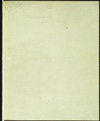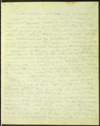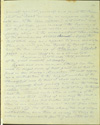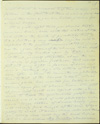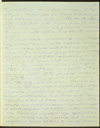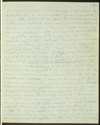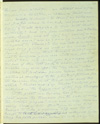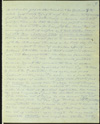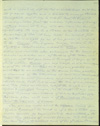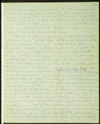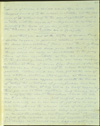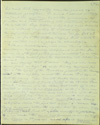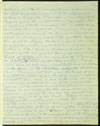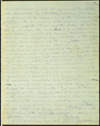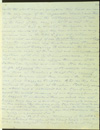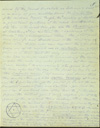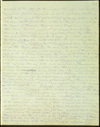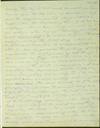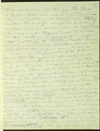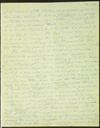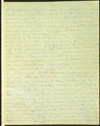Mahatma Letter No. 111
| Quick Facts | |
|---|---|
| People involved | |
| Written by: | Koot Hoomi |
| Received by: | A. P. Sinnett |
| Sent via: | unknown |
| Dates | |
| Written on: | unknown |
| Received on: | July 1883 |
| Other dates: | unknown |
| Places | |
| Sent from: | unknown |
| Received at: | London |
| Via: | unknown |
This is Letter No. 111 in The Mahatma Letters to A. P. Sinnett, 4th chronological edition. It corresponds to Letter No. 59 in Barker numbering. An unpublished letter that precedes this one was written on June 6, 1883.
< Prev letter chrono
Next letter chrono >
< Prev letter Barker
Next letter Barker >
Cover sheet
|
Received London about July, 1883. |
NOTES: |
Page 1 transcription, image, and notes
|
With whatever shortcomings my always indulgent "lay-chela" may have to charge me, he will, it appears, credit me with having given him a new source of enjoyment. For even the sombre prophecy of Sir Charles Turner (a recent obscuration of his) that you would fall into Roman Catholicism as the inevitable outcome of your dabbling in Theosophy and believing in the "K.H." maya — has not dampened the ardour of your propaganda in the gay world of London. If this zeal should be cited by the Altruist of Rothney, in support of his declaration that your grey vesicles are surcharged with Tzigadze Akasa, it will still doubtless be balm to your wounded feelings to know that you are essentially aiding to build the bridge over which the British metaphysicians may come within thinking distance of us! It is the custom among some good people to glance back at their life's path from the hillocks of time they annually surmount. So, if my hope has not betrayed me you must have been mentally comparing your present "greatest pleasure" & "constant occupation" with that which was so in the olden time, when you threaded the streets of your metropolis, where the houses are as if "painted in Indian ink," & a day's sunshine is an event to remember. You have measured |
NOTES:
|
Page 2
|
yourself against yourself, and found the Theosophist an "Anak" morally, as compared with the "old man" (the beau valseur); is it not so? Well, this is, perhaps, your reward — the beginning of it: the end you will realize in Devachan, when "floating along" in the circumambient ether, instead of the circummuded British Channel — foggy though that state may now appear to your mind's eye. Then only will you "see thyself by thyself" and learn the true meaning of Atmânam, âtmanâ paśya: — "To know itself e'en as a shining light Requires no light to make itself perceived . . ." of the great Vedanta Philosophy. Again and once more, an attempt has been made to dispel some of that great mist that I find in Mr. Massey's Devachan. It will appear as a contribution to the August number of the Theosophist, and to that I shall refer Mr. Massey and yourself. Quite possibly even then the "obscuration" will not be removed and it may be thought that the intended explanation is nothing of the kind; and that, instead of winding the clock, a clumsy hand has but broken out some cogs. This is our misfortune, and I doubt if we shall ever get quite free of these obscurities and alleged contradictions; since there is no way to bring the askers and respondents face to face. Still at the |
|
NOTES:
|
Page 3
|
worst it must be conceded that there is some satisfaction in the fact that there is now a ford across this river and you are building spans for a royal bridge. It is quite right that you should baptize your new brain-babe with the waters of Hope; and, within the limits of possibility that by it "a further and very sensible impulse will be imparted to the present movement." But, friend, even the "green cheese" of the shining moon is periodically lunched upon by Rahu; so do not think yourself altogether above the contingency of popular fickleness, that would put out your light in favour of some new man's "farthing dip." The culture of Society more often inclines to lawn-tennis philosophy than to that of the banned "adepts," whose wider game has worlds for balls, and etheric space for its shaven lawn. The plat of your first book was spiced with phenomena to tickle the spiritualistic palate: this second one is a dish of cold philosophy, and in your "large section of London Society" you will scarcely find enough of the wine of sympathy to wash it down. Many, who now think you mildly mad will buy the book to find out if a commission De lunatico should issue |
|
NOTES:
|
Page 4
|
to prevent your doing more damage; but of all your readers few are likely to follow your lead towards our ashrum. Still the theosophist's duty is like that of the husbandman; to turn his furrows and sow his grains as best he can: the issue is with nature, and she, the slave of Law. I shall waste no condolences upon the poor "lay-chelas" because of the "delicate weapons they can alone work with." A sorry day it would be for mankind if any sharper or deadlier ones were put in their unaccustomed hands! Ah! you would concur with me, my faithful friend, if you could but see the plaint one of them has just made on account of the agonizing results of the poisoned weapons he got the wielding of, in an evil hour, through the help of a sorcerer. Crushed morally, by his own selfish impetuosity; rotting physically from diseases engendered by the animal gratifications he snatched with "demon" help; behind him a black memory of wasted chances and hellish successes; before him a pall of dark despair, — of avitchi, — this wretched man turns his impotent rage against our "starry science" and ourselves, and hurls his ineffectual curses at those he vainly besieged |
|
NOTES:
|
Page 5
|
for more powers in chelaship, and whom he deserted for a necromantic "Guru" who now leaves the victim to his fate. Be satisfied, friend, with your "delicate weapons"; if not as lethal as the discus of Vishnu, they can break down many barriers if plied with power. The poor wretch in question confesses to a course of "lies, breaches of faith, hatreds, temptings or misleading of others, injustices, calumnies, perjuries, false pretences," etc. The "risk" he "voluntarily took," but he adds, "if they (we) had been good and kind as well as wise and powerful, they (we) would have certainly prevented me from undertaking a task to which they knew I was unequal." In a word, we, who have gained our knowledge, such as it is, by the only practicable method, and who have no right to hinder any fellow man from making the attempt (though we have the right to warn, and we do warn every candidate), we are expected to take upon our own heads the penalty of such interference, or try to save ourselves from the same by making incompetents into adepts in spite of themselves! Because we did not do this, he is "left to linger out a wretched existence as an animated poison bag, full of mental, moral, and physical corruption." This man has, in despair, |
|
NOTES:
|
Page 6
|
turned from a "heathen" an atheist and a free-thinker — a Christian, or rather a theist, and now humbly "submits" to Him (an extra cosmical God for whom he has even discovered a local) and to all delegated by Him with lawful authority." And we, poor creatures, are "traitors, Liars, Devils, and all my (his) crimes (as enumerated above) are as a shining robe of glory compared to Theirs:" — his capitals and underscorings being quoted as well as his words! Now friend, put away that thought that I ought not to compare your case with his, for I do not. I have only given you a glimpse into the hell of this lost soul, to show you what disaster may come upon the "lay-chela" who snatches at forbidden power before his moral nature is developed to the point of fitness for its exercise. You must think well over the article "Chelas and Lay Chelas" which you will find in the Supplement of the July Theosophist. So the great Mr. Crookes has placed one foot across the threshold for the sake of reading the Society's papers? Well and wisely done, and really brave of him. Heretofore he was bold enough to take a similar step and loyal enough to truth to disappoint his colleagues by making his facts public. When he was seeing his |
|
NOTES: |
Page 7
|
invaluable paper smothered in the "Sections" and the whole Royal Society trying to cough him down, metaphorically if not actually, as its sister Society in America did to that martyr, Hare — he little thought how perfect a revenge Karma had in store for him. Let him know that its cornucopia is not yet emptied, and that Western Science has still three additional states of matter to discover. But he should not wait for us to condense ourselves up to the stethescopic standard as his Katy did; for we men are subject to laws of molecular affinity and polaric attraction which that sweet simulacrum was not hampered with. We have no favourites, break no rules. If Mr. Crookes would penetrate Arcana beyond the corridors the tools of modern science have already excavated, let him — Try. He tried and found the Radiometer; tried again, and found Radiant matter; may try again and find the "Kama-rupa" of matter — its fifth state. But to find its Manas he would have to pledge himself stronger to secrecy than he seems inclined to. You know our motto, and that its practical application has erased the word "impossible" from the occultist's vocabulary. If he wearies not of trying, he may discover that most noble of all facts, his true SELF. But he will have to penetrate many strata before he comes to It. And to begin with let him rid himself of the maya that any man living can set up "claims" upon Adepts. He may create irresistible attractions and compel their attention, but they |
NOTES:
|
Page 8
|
will be spiritual, not mental or intellectual. And this bit of advice applies and is directed to several British theosophists, and it may be well for them to know it. Once separated from the common influences of Society, nothing draws us to any outsider save his evolving spirituality. He may be a Bacon or an Aristotle in knowledge, & still not even make his current felt a feather's weight by us, if his power is confined to the Manas. The supreme energy resides in the Buddhi; latent — when wedded to Atman alone, active and irresistible when galvanized by the essence of "Manas" and when none of the dross of the latter commingles with that pure essence to weigh it down by its finite nature. Manas, pure and simple, is of a lower degree, and of the earth earthly: and so your greatest men count but as nonentities in the arena where greatness is measured by the standard of spiritual development. When the ancient founders of your philosophical schools came East, to acquire the lore of our predecessors, they filed no claims, except the single one of a sincere and unselfish hunger for the truth. If any now aspire to found new schools of science and philosophy the same plan will win -- if the seekers have in them the elements of success. Yes; you are right about the Society for Psychic Research: its work is of a kind to tell upon public opinion by experimentally demonstrating the elementary phases of Occult Science. H. S. Olcott has been trying to convert each of the Indian Branches |
NOTES: |
Page 9
|
into such a school of research, but the capacity for sustained independent study for knowledge's sake is lacking, and must be developed. The success of the S.P.R. will greatly aid in this direction and we wish it well. I also go with you in your views as to the choice of the new President of the B.T.S.; in fact I concurred, I believe, before the choice was made. There is no reason why you should not "attempt mesmeric cures" by the help not of your locket but the power of your own will. Without this latter in energetic function, no locket will do much good. The hair in it is in itself but an "accumulator" of the energy of him, who grew it, and can no more cure of itself than stored electricity can turn a wheel until liberated and conducted to the objective point. Set your will in motion and you at once draw upon the person upon whose head it (the hair not the will) grew, through the psychic current which ever runs between himself and his severed tress. To heal diseases it is not indispensable, however desirable, that the psychopathist should be absolutely pure; there are many in Europe and elsewhere who are not. If the healing be done under the impulse of perfect benevolence, unmixed with any latent selfishness, the philanthropist sets up a current which runs like a fine thrill through the sixth condition of matter, and is felt by him whom you summon to your help, if not at that moment engaged in some work which compels him to be repellent to all extraneous influences. The possession of a lock of any adept's |
NOTES:
|
Page 10
|
hair is of course a decided advantage, as a better tempered sword is to the soldier in battle; but the measure of its actual help to the psychopathist will be in ratio with the degree of will power he excites in himself, and the degree of psychic purity in his motive. The talisman & his Buddhi are in sympathy. Now that you are at the centre of modern Buddhistic exegesis, in personal relations with some of the clever commentators (from whom the holy Devas deliver us!) I shall draw your attention to a few things which are really as discreditable to the perceptions of even non-initiates, as they are misleading to the general public. The more one reads such speculations as those of Messrs. Rhys Davids, Lillie, etc. — the less can one bring himself to believe that the unregenerate Western mind can ever get at the core of our abstruse doctrines. Yet hopeless as their cases may be, it would appear well worth the trouble of testing the intuitions of your London members — of some of them, at any rate — by half expounding through you one or two mysteries and leaving them to complete the chain themselves. Shall we take Mr. Rhys Davids as our first subject, and show that indirectly as he has done it yet it is himself who strengthened the absurd ideas of Mr. Lillie, who fancies to have proved belief in a personal God in ancient Buddhism. Mr. Rhys Davids' "Buddhism" is full of the sparkle of our most important esotericism; but always, as it would seem, beyond not only |
|
NOTES:
|
Page 11
|
his reach but apparently even his powers of intellectual perception. To avoid "absurd metaphysics" and its inventions, he creates unnecessary difficulties and falls headlong into inextricable confusion. He is like the Cape Settlers who lived over diamond mines without suspecting it. I shall only instance the definition of "Avalokitesvara" on p.p. 202 and 203. There, we find the author saying that which to any occultist seems a palpable absurdity: — "The name Avalokitesvara, which means 'the Lord who looks down from on high,' is a purely metaphysical invention. The curious use of the past particle passive 'avalokita' in an active sense is clearly evident from the translations into Tibetan and Chinese." Now saying that it means: "the Lord who looks down from on high," or, as he kindly explains further — "the Spirit of the Buddhas present in the church," is to completely reverse the sense. It is equivalent to saying "Mr. Sinnett looks down from on high (his Fragments of Occult Truth) on the British Theos. Society," whereas it is the latter that looks up to Mr. Sinnett, or rather to his Fragments as the (in their case only possible) expression and culmination of the knowledge sought for. This is no idle simile and defines the exact situation. In short, Avalokita Isvar literally interpreted means "the Lord that is seen." "Iswara" implying moreover, rather the adjective than the noun, lordly, self-existent lordliness, not Lord. It is, when correctly interpreted, in one sense "the divine Self perceived or seen by Self," the Atman or 7th principle ridded of its mayavic distinction |
|
NOTES:
|
Page 12
|
from its Universal Source — which becomes the object of perception for, and by the individuality centred in Buddhi, the 6th principle, — something that happens only in the highest state of Samadhi. This is applying it to the microcosm. In the other sense Avalokitesvara implies the 7th Universal Principle, as the object perceived by the Universal Buddhi or "Mind" or Intelligence which is the synthetic aggregation of all the Dhyan Chohans, as of all other intelligences whether great or small, that ever were, are, or will be. Nor is it the "Spirit of Buddhas present in the Church," but the Omnipresent Universal Spirit in the temple of nature — in one case; and the 7th Principle — the Atman in the temple — man — in the other. Mr. Rhys Davids might have, at least remembered, the (to him) familiar simile made by the Christian Adept, the Kabalistic Paul: "Know ye not that ye are the temple of God, and that the Spirit of God dwelleth in you" — and thus avoided to have made a mess of the name. Though as a grammarian he detected the use of the "past particle passive" yet he shows himself far from an inspired "Panini" in overlooking the true cause and saving his grammar by raising the hue and cry against metaphysics. And yet, he quotes Beal's Catena as his authority, for the invention, when, in truth, this work is perhaps the only one in English that gives an approximately correct explanation of the word, at any rate, on page 374. "Self-manifested" — How? it is asked. "Speech or Vach was regarded as the Son or the manifestation of the Eternal Self, and was adored under the name of Avalokitesvara, the manifested God." This shows as clearly as can be — that |
NOTES:
|
Page 13
|
Avalokitesvara is both the unmanifested Father & the manifested Son, the latter proceeding from, and identical with, the other; — namely, the Parabrahm and Jivatman, the Universal and the individualized 7th Principle, — the Passive and the Active, the latter the Word, Logos, the Verb. Call it by whatever name, only let these unfortunate, deluded Christians know that the real Christ of every Christian is the Vach, the "mystical Voice," while the man Jeshu was but a mortal like any of us, an adept more by his inherent purity and ignorance of real Evil, than by what he had learned with his initiated Rabbis and the already (at that period) fast degenerating Egyptian Hierophants and priests. A great mistake is also made by Beal who says: "this name (Avalokiteswara) in Chinese took the form of Kwan-Shai-yin, and the divinity worshipped under that name (was) generally regarded as a female." (374) Kwan-shai-yin — or the universally manifested voice "is active — male; and must not be confounded with Kwan-yin, or Buddhi the Spiritual Soul (the sixth Pr.) and the vehicle of its "Lord." It is Kwan-yin that is the female principle or the manifested passive, manifesting itself "to every creature in the universe, in order to deliver all men from the consequences of sin" — as rendered by Beal, this once quite correctly (383), while Kwan-shai-yin, the "Son identical with his Father" is the absolute activity, hence — having no direct relation to objects of sense is — Passivity. What a common ruse it is of your Aristoteleans. |
|
NOTES: |
Page 14
|
with the sleuth hound's persistence they track an idea to the very verge of the "impassable chasm," and then brought to bay leave the metaphysicians to take up the trail if they can, or let it be lost. It is but natural that a Christian theologian, a missionary, should act upon this line, since — as easily perceived even in the little I gave out just now — a too correct rendering of our Avalokitesvara and Kwan-Shai-Yin might have very disastrous effects. It would simply amount to showing Christendom, the true and undeniable origin of the "awful and incomprehensible" mysteries of its Trinity, Transubstantiation, Immaculate conception, as also whence their ideas of the Father, Son, Spiritus and — Mother. It is less easy to shuffle al piaccere the cards of Buddhistic chronology than those of Chrishna and Christ. They cannot place — however much they would — the birth of our Lord Sangyas Buddha A.D. as they have contrived to place that of Chrishna. But why should an atheist and a materialist like Mr. Rhys Davids so avoid the correct rendering of our dogmas — even when he happens to understand them, — which does not happen every day — is something surpassingly curious! In this instance the blind and guilty Rhys Davids leads the blind and innocent Mr. Lillie into the ditch; where the latter catching at the proffered straw rejoices in the idea that Buddhism teaches in reality — a personal God!! Does your B.T.S. know the meaning of the white and black interlaced triangles, of the Parent Society's seal that it has also adopted? Shall I explain? — the double triangle |
|
NOTES:
|
Page 15
|
viewed by the Jewish Kabalists as Solomon's Seal, is, as many of you doubtless know the Sri-antara of the archaic Aryan Temple, the "mystery of Mysteries," a geometrical synthesis of the whole occult doctrine. The two interlaced triangles are the Buddhangums of Creation. They contain the "squaring of the circle," the "philosophical stone," the great problems of Life and Death, and — the Mystery of Evil. The chela who can explain this sign from every one of its aspects — is virtually an adept. How is it then that the only one among you, who has come so near to unravelling the mystery is also the only one who got none of her ideas from books? Unconsciously she gives out — to him who has the key — the first syllable of the Ineffable name! Of course you know that the double-triangle — the Satkiri Chakram of Vishnu — or the six-pointed star, is the perfect seven. In all the old Sanskrit works — Vedic and Tantrik — you find the number 6 mentioned more often than the 7 — this last figure, the central point being implied, for it is the germ of the six and their matrix. It is then thus . . . [At this point in the original there is a rough drawing of the interlaced triangles inscribed in a circle. — ED.] — the central point standing for seventh, and the circle, the Mahakasha — endless space — for the 7th Universal Principle. In one sense, both are viewed as Avalokitesvara, for they are respectively the Macrocosm and the microcosm. The interlaced triangles — the upper pointing one — is Wisdom concealed, and the downward pointing one — Wisdom revealed (in the phenomenal world). The circle indicates the bounding, circumscribing quality |
NOTES:
|
Page 16
|
of the All, the Universal Principle which, from any given point expands so as to embrace all things, while embodying the potentiality of every action in the Cosmos. As the point then is the centre round which the circle is traced — they are identical and one, and though from the standpoint of Maya and Avidya — (illusion and ignorance) — one is separated from the other by the manifested triangle, the 3 sides of which represent the three gunas — finite attributes. In symbology the central point is Jivatma (the 7th principle), and hence Avalokitesvara, the Kwan-Shai-yin, the manifested "Voice" (or Logos), the germ point of manifested activity; — hence — in the phraseology of the Christian Kabalists "the Son of the Father and Mother," and agreeably to ours — "the Self manifested in Self — Yih-sin, the "one form of existence," the child of Dharmakaya (the universally diffused Essence), both male and female. Parabrahm or "Adi-Buddha" while acting through that germ point outwardly as an active force, reacts from the circumference inwardly as the Supreme but latent Potency. The double triangles symbolize the Great Passive and the Great Active; the male and female; Purusha and Prakriti. Each triangle is a Trinity because presenting a triple aspect. The white represents in its straight lines: Gnanam — (Knowledge); Gnata — (the Knower); and Gnayam — (that which is known). The black-form, colour, and substance, also the creative, preservative, and destructive forces and are mutually correlating. Etc., etc. Well may you admire and more should you wonder at the marvellous lucidity of that remarkable seeress, who ignorant of Sanskrit or Pali, and thus shut out from their metaphysical treasures, has yet seen a great light shining from behind the dark bills of exoteric religions. How, think you, did the "Writers of the Perfect Way" come to know that Adonai was the Son and not the Father; or that the third Person of the Christian Trinity is — female? |
NOTES:
|
Page 17
|
Verily, they lay in that work several times their hands upon the keystone of Occultism. Only does the lady — who persists using without an explanation the misleading term "God" in her writings — know how nearly she comes up to our doctrine when saying: — "Having for Father, Spirit which is Life (the endless Circle or Parabrahm) and for Mother the Great Deep, which is Substance (Prakriti in its undifferentiated condition) — Adonai possesses the potency of both and wields the dual powers of all things." We would say triple, but in the sense as given this will do. Pythagoras had a reason for never using the finite, useless figure — 2, and for altogether discarding it. The ONE, can, when manifesting, become only 3. The unmanifested when a simple duality remains passive and concealed. The dual monad (the 7th and 6th principles) has, in order to manifest itself as a Logos, the "Kwan-shai-yin" to first become a triad (7th, 6th and half of the 5th); then, on the bosom of the "Great Deep" attracting within itself the One Circle — form out of it the perfect Square, thus "squaring the circle" — the greatest of all the mysteries, friend — and inscribing within the latter the — word (the Ineffable name) — otherwise the duality could never tarry as such, and would have |
NOTES: |
Page 18
|
to be reabsorbed into the one. The "Deep" is Space — both male and female. "Purush (as Brahma) breathes in the Eternity: when 'he' in-breathes — Prakriti (as manifested Substance) disappears in his bosom; when 'he' out-breathes she reappears as Maya," says the Sloka. The One reality is Mulaprakriti (undifferentiated Substance) — the "Rootless root," the. . . But we have to stop, lest there should remain but little to tell for your own intuitions. Well may the Geometer of the R.S. not know that the apparent absurdity of attempting to square the circle covers a mystery ineffable. It would hardly be found among the foundation stones of Mr. Roden Noel's speculations upon the "pneumatical body . . . of our Lord," nor among the debris of Mr. Farmer's "A New Basis of Belief in Immortality"; and to many such metaphysical minds it would be worse than useless to divulge the fact, that the Unmanifested Circle — the Father, or Absolute Life — is non-existent outside the Triangle and Perfect Square, and — is only manifested in the Son; and that it is when, reversing the action and returning to its absolute state of Unity, and the square expands once more into the Circle — that "the Son returns to the bosom of the Father." There it remains until called back by his Mother — the "Great Deep," to remanifest as a triad — the Son partaking at once, |
NOTES:
|
Page 19
|
of the Essence of the Father, and of that of the Mother — the active Substance, Prakriti in its differentiated condition. "My Mother — (Sophia — the manifested Wisdom) took me" — says Jesus in a Gnostic treatise; and he asks his disciples to tarry till he comes. . . . The true "Word" may only be found by tracing the mystery of the passage inward and outward of the Eternal Life, through the states typified in these three geometric figures. The criticism of "A Student of Occultism" (whose wits are sharpened by the mountain air of his home) and the answer of "S.T.K. . . . Chary" (June Theosophist) upon a part of your annular and circular expositions need not annoy or disturb in any way your philosophic calm. As our Pondichery chela significantly says, neither you nor any other man across the threshold has had or ever will have the "complete theory" of Evolution taught him; or get it unless he guesses it for himself. If anyone can unravel it from such tangled threads as are given him, very well; and a fine proof it would indeed be of his or her spiritual insight. Some — have come very near it. But yet there is always with the best of them just enough error, — colouring and misconception; the shadow of Manas projecting across the field of Buddhi — to prove the eternal law that only the unshackled Spirit shall see the things |
|
NOTES:
|
Page 20
|
of the Spirit without a veil. No untaught amateur could ever rival the proficient in this branch of research; yet the world's real Revelators have been few, and its pseudo-Saviours legion; and fortunate it is if their half-glimpses of the light are not, like Islam, enforced at the sword's point, or like Christian Theology, amid blazing faggots and in torture chambers. Your Fragments contain some — still very few errors, due solely to your two preceptors of Adyar, one of whom would not, and the other could not tell you all. The rest could not be called mistakes — rather incomplete explanations. These are due, partly to your own imperfect education in your last theme — I mean the ever-threatening obscurations — partly to the poor vehicles of language at our disposal, and in part again, to the reserve imposed upon us by rule. Yet, all things considered, they are few and trivial; while as to those noticed by "A Student, etc." (the Marcus Aurelius of Simla) in your No. VII, it will be pleasant for you to know that every one of them, however now seeming to you contradictory, can (and if it should seem necessary shall) be easily reconciled with facts. The trouble is that (a) you cannot be given the real figures and difference in the Rounds, and (b) that you do not open doors enough for explorers. The bright Luminary of the B.T.S. and the Intelligences that surround her (embodied I mean) may help you to |
NOTES:
|
Page 21
|
see the flaws: at all events Try. "Nothing was ever lost by trying." You share with all beginners the tendency to draw too absolutely strong inferences from partly caught hints, and to dogmatize thereupon as though the last word had been spoken. You will correct this in due time. You may misunderstand us, are more than likely to do so, for our language must always be more or less that of parable and suggestion, when treading upon forbidden ground; we have our own peculiar modes of expression and what lies behind the fence of words is even more important than what you read. But still — TRY. Perhaps if Mr. S. Moses could know just what was meant by what was said to him, and about his Intelligences, he would find all strictly true. As he is a man of interior growth, his day may come and his reconciliation with "the Occultists" be complete. Who knows? Meanwhile, I shall, with your permission, close this first volume. |
NOTES: |
Context and background
An unpublished letter that precedes this one was written on June 6, 1883. In that letter, Sinnett was describing his understanding of planetary chains, and about spiritualism; KH wrote across that page, "All wrong."
Physical description of letter
The original is in the British Library, Folio 2. George Linton and Virginia Hanson described the letter this way:
KH script in blue ink on 20 standard-sized sheets of rippled white paper, on one side only. On page 8 there is a drawing of two interlaced triangles inside a circle, with a dot in the center.[1]
See page 15 to see the triangles mentioned above.
Publication history
Commentary about this letter
Notes
- ↑ George E. Linton and Virginia Hanson, eds., Readers Guide to The Mahatma Letters to A. P. Sinnett (Adyar, Chennai, India: Theosophical Publishing House, 1972), 178.
